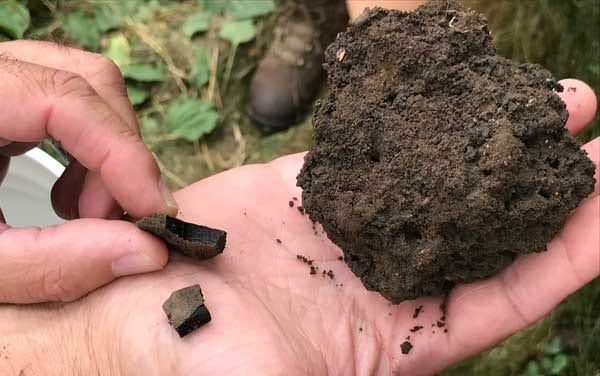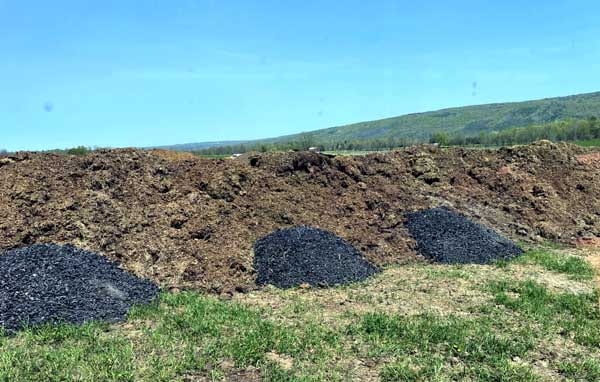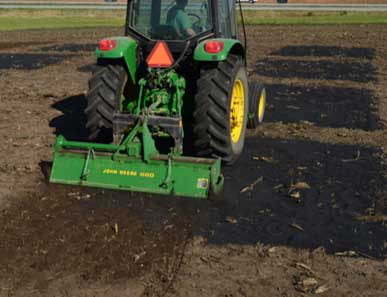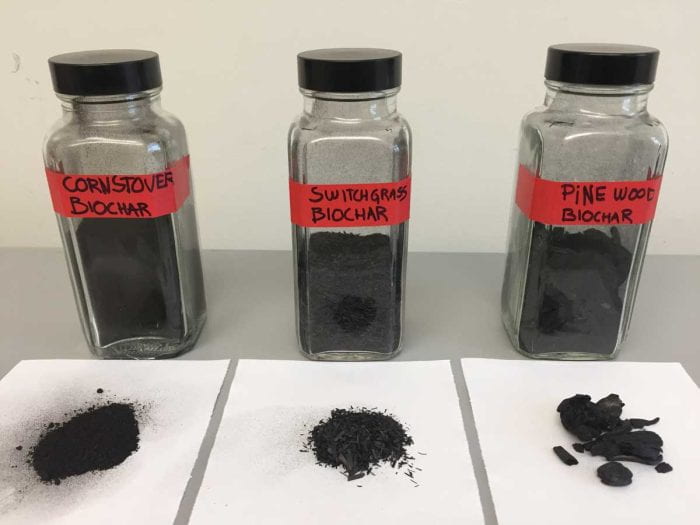Biochar
A basic overview of biochar, general resources, and information targeted towards agricultural applications for NYS producers.
Biochar is a charcoal-like product made from sustainably sourced organic materials, either low-value or waste materials, for use in agricultural and environmental applications. It is one of the most readily available tools for soil, agronomic, climate, and ecosystem benefits. It has significant potential to improve soil health, aid in waste management, provide clean energy, and for climate mitigation and adaptation. It is not a new technology, but rather an area of study that was sparked by research on the Terra Preta de Indio soils of the Amazon.
Featured Video
Biochar Basics
- Biochar: an introduction to a sustainable soil amendment: Deborah Aller, PhD, Agricultural Stewardship Specialist, CCE – Suffolk
- Introduction to the biochar community: Tom Miles, Executive Director – USBI (United States Biochar Initiative)
- Biochar for climate mitigation: withdrawing carbon dioxide from the atmosphere and sequestering it in soil: Johannes Lehmann, PhD, Professor – Cornell University
Biochar Uses & Applications
Biochar has several unique chemical and physical properties that make it very useful for numerous applications. There are many expanding markets for biochar, including:
-
Agriculture and horticulture industries
-
Forest and rangeland management
-
Mine land reclamation
-
Urban environments (woodlands & golf courses)
-
Gardening
-
Industrial applications
-
Water and wastewater treatment
-
Building materials

Clump of orchard soil with biochar. Photo: Debbie Aller
Biochar Impacts on the Soil Environment
In agriculture the application of biochar results in both direct and indirect impacts to the soil environment.

Mixing biochar with compost. Photo: Jon Hunt
Its high internal porosity, surface area, and reactivity increase:
Soil pH (liming effect)
Cation exchange capacity
Aggregate stability
Nutrient cycling
Microbial activity
Water and nutrient retention
While decreasing:
Bulk density
Greenhouse gas emissions
Leaching and volatilization of nitrogen in some, but not all soils
Additionally, biochar can help buffer against abiotic stresses, such as salt, heat, cold, toxins, and drought. It also affects:
Seed germination
Flowering
Disease resistance

Furthermore, its condensed aromatic carbon structure can persist in soils for hundreds to thousands of years, helping to build soil organic carbon and contributing to long-term carbon sequestration.

Biochar incorporation. Photo: David Laird
Biochar’s Potential to Improve Plant Growth
Biochar has the potential to improve plant growth, particularly in acidic, sandy, and low OM soils.
When biochar is mixed with organic and/or mineral fertilizer (e.g., compost, manure, nutrients), the benefit to crop yield and nutrient use efficiency has been found to be significantly greater than when biochars are applied alone.

Before making biochar applications, it’s essential to understand the problem you are trying to solve to identify the right biochar type and optimum rate.
Feedstock
Pyrolysis conditions
Biochar properties
Application rate
Soil properties
Management practices
Climate
Videos: Biochar
Biochar Basics
The Science Behind Biochar
Ornamental Nursery Applications
Landscape Applications
Johannes Lehmann Research
Biochar in NYS -Debbie Aller
Biochar Intro – Debbie Aller
Financial Assistance
Biochar & Soil Amendments – Debbie Aller
Featured Resources
United States Biochar Initiative
A not-for-profit organization promoting the sustainable production and use of biochar through research, policy, technology and doing it!
Insternational Biochar Initiative
IBI provides a platform for fostering stakeholder collaboration, good industry practices, and environmental and ethical standards to support biochar systems that are safe and economically viable.
Cornell University - Johannes Lehmann
Professor of soil biogeochemistry and soil fertility management at Cornell University, received his graduate degrees in Soil Science at the University of Bayreuth, Germany.
Cornell University - Jillian Goldfarb
Associate Professor and Director of Undergraduate Studies, Biological and Environmental Engineering. Her research tackles issues surrounding energy generation and its impact on the environment.
The Biochar Journal
Cutting edge information and practical guidance showing how the use of biochar and other climate friendly techniques can not only boost economic and environmental resilience but also regenerate local, regional and global ecosystems.
Resource Library
Trainings & Conferences
IBI Biochar Trainings
Interested in learning to become an effective biochar advocate and educator, equipped with essential knowledge for training and communicating biochar? Explore virtual and in-person learning opportunities for both seasoned and emerging biochar professionals. More info
2025 North American Biochar & Bioenergy Conference
This year, the annual conference will take place in Minneapolis from September 15 to 18. Join the leaders shaping the future of biochar at the premier event designed to accelerate market adoption, scale production, and expand applications across industries. More info
Biochar Decision Tools
Pacific Northwest Biochar Tools*
The USDA – ARS and partners developed a series of decision support tools for biochar users. These tools, which can be found at the link below, allow potential biochar end users to learn about the properties of different biochars, assess their soil needs, select the most appropriate type of biochar and application rate, as well as determine if applying biochar is a good investment.
Dynamic Soil Properties Response to Biochar – tool available through USDA Web Soil Survey: https://websoilsurvey.sc.egov.usda.gov/
Financial Assistance program. Available in NYS.
USDA-NRCS/USBI deep dive webinar series on Code 336 Soil Carbon Amendment from USDA NRCS. Learn how to navigate the NRCS financial assistance program to benefit your soil health goals.
Natural Resources Conservation Service, Conservation Practice Standard: Soil Carbon Amendment Code 336 (previously Code 808).
-Provides financial assistance for the application of biochar and compost on farms.
Biochar Suppliers and Standards
List of biochar suppliers and manufacturers
The USBI maintains the most updated list of companies across North America selling biochar products and technologies. (for information only, no endorsement provided).
Biochar Product Standards
IBI – Standardized Product Definition and Product Testing Guidelines for Biochar That Is Used in Soil. Version 2.1.
US Biochar Initiative (USBI) Fact Sheets
Biochar Guidelines for Agricultural Applications
Download Print Version | Download Digital Version
Beyond Application: Learning More About Biochar
Filter Pollutants with Biochar
Research shows benefits of adding biochar to stormwater media mixes
Biochar in Compost
Research shows adding biochar activates the composting process by enhancing the activity of microorganisms
Biochar Removes Carbon
Research shows that biochar, a nature-based strategy, has enormous potential to remove CO2 from the atmosphere as part of an overall climate change mitigation strategy
Webinars
A 4-part webinar series organized by Cornell Cooperative Extension of Suffolk County that presents information from experts and practitioners on a wide range of topics including an introduction to biochar; advances in biochar science; and nursery and landscape research and applications.
YouTube playlist with all four webinars.
Descriptions of the four webinars (links go to Cornell’s video player and have a transcript):
View: Webinar #1 – Biochar Basics
- Biochar: an introduction to a sustainable soil amendment
Deborah Aller, PhD, Agricultural Stewardship Specialist, CCE – Suffolk - USBI: Introduction to the biochar community
Tom Miles, Executive Director – USBI (United States Biochar Initiative) - Biochar for climate mitigation: withdrawing carbon dioxide from the atmosphere and sequestering it in soil
Johannes Lehmann, PhD, Professor – Cornell University
View: Webinar #2 – The Science Behind Biochar
- Properties of biochar and torrefied biomass: the science in the analytical black box
Jillian Goldfarb, PhD, Assistant Professor – Cornell University - Advances in biochar production
Bernardo Del Campo, PhD, President – ARTi (Advanced Renewable Technology International) - Valorization of biochar: Applications in nutrient recycling from animal manure
Chumki Banik, PhD, Research Associate – Iowa State University
View – Webinar #3 – Ornamental Nursery Applications of Biochar
- Biochar as a substrate in container production
Neil Mattson, PhD, Associate Professor – Cornell University - Biochar nursery trials in Long Island container and field production
Deborah Aller, PhD, Agricultural Stewardship Specialist, &
Mina Vescera, Nursery/Landscape Specialist, CCE-Suffolk - Biochar as a soil amendment for blueberry production
Bryan Sales, PhD, Assistant Professor – University of North Carolina at Pembroke
View – Webinar #4 – Landscape Applications of Biochar
- Biochar and biosolids increase tree growth and improve soil quality for urban landscapes
Bryant Scharenbroch, PhD Assistant Professor – University of Wisconsin-Stevens Point - Biochar as a soil amendment to improve tree survival and health in the urban environment
Emma Schaffert, The F. A. Bartlett Tree Experts, North Carolina - Field and landscape applications of biochar using a variety of methods
Andrew Borner, Owner of Natural Plant Solutions – Shaw Island, WA
On-farm biochar research projects in NYS
Publicly available, funded by Northeast SARE
American Farmland Trust - Biochar
In this resource by the American Farmland Trust they discuss some of the barriers to adoption across the US and various biochar initiatives . Visit: https://farmland.org/biochar/
Frequently Asked Questions
What is biochar?
A solid, carbon-rich material with agricultural, environmental, and industrial applications. In agriculture, biochar is applied to soil to improve soil quality and crop productivity while sequestering carbon.
How is it made?
There are several methods for producing biochar including pyrolysis in various kiln designs, gasification, hydrothermal carbonization, flash carbonization and torrefaction. In all these methods feedstock organic material undergoes some level of thermochemical decomposition or
conversion that stabilizes carbon.
- Pyrolysis is the thermochemical decomposition of organic material by heating at
temperatures from 300 °C to over 750 °C, in the absence of oxygen. - Gasification is the thermochemical conversion of organic material by heating at
temperatures similar to pyrolysis in the presence of a small amount of oxygen or steam. - Hydrothermal carbonization is the thermochemical conversion of organic material in
heated (180-250°C) and pressurized (2-6 MPa) water. - Flash carbonization is the thermochemical conversion of packed organic material under
flash fire and pressure (1-2 MPa). - Torrefaction is the thermochemical conversion of organic material by heating at
temperatures from 200°C to 300°C in the absence of oxygen.
What is biochar made from?
What is a feedstock?
The starting organic material that will be pyrolyzed to make biochar. Feedstocks include almost any organic waste such as woodchips, corn stover residue, rice hulls, sugarcane bagasse, manure, switchgrass, coconut husks, biosolids, food waste, etc. The best feedstock is a waste product found close to the production facility because of lower transportation costs and reduced environmental impact
How much biochar would be produced by processing 1 ton of biomass?
This answer depends on the pyrolysis method, temperature used, and the type of biomass. Lower temperature pyrolysis typically yields more biochar per unit of feedstock than higher pyrolysis temperatures. Slow pyrolysis (residence time minutes to hours) typically yields more biochar than fast
pyrolysis (residence time seconds to minutes). Figure 1 in Spokas et al. 2010 shows the relationship between biochar yield and pyrolysis temperature for a given biochar type.
| Biomass Feedstock | Pyrolysis | Temperature | Biochar Yield | Yield Est.* | Reference |
| Palm fiber | Slow pyrolysis | 300°C | 54.83% (% feedstock dry wt.) |
1,096.6 lb. | Selvarajoo et al. 2020 |
| Palm fiber | Slow pyrolysis | 900°C | 26.67% (% feedstock dry wt.) |
533.4 lb. | Selvarajoo et al. 2020 |
| Kentucky Bluegrass see screening | Gasification | 650-750°C | ~32% | 640 lb. | Phillips et al. 2018 |
| Macademia nutshell | Fast pyrolysis | 400-500°C | 29.7% (% feedstock dry wt.) |
594 lb. | Hasan et al. 2022 |
| Macademia nutshell | Slow pyrolysis | 400-500°C | 41.3% (% feedstock dry wt.) |
826 lb. | Hasan et al. 2022 |
| Biosolids | Slow pyrolysis | 500-600°C | 45-36% | 900-720 lb. | Kundu et al. 2021 |
| Wood | Hydrothermal carbonization | 200°C | 66% | 1,320 lb. | Funke et al. 2010 |
*From 1 ton feedstock
Is biochar different than charcoal?
Why has biochar adoption been slow?
Adoption has been slow for many reasons including:
- Lack of education and awareness of biochar’s benefits
- Lack of decision support tools
- Currently limited regional and local production facilities
- Uncertainty of site-specific impacts
- Lack of information on application and management recommendations
- Cost and availability
- Inconsistent production and characterization
- Variable economic outcomes
However, while barriers to adoption still exist, active research, extension, policies, and financial
assistance programs are being developed to increase adoption.
Is biochar a ‘silver-bullet’ solution?
Biochar, like all technologies, is not a silver bullet to existing agriculture and environmental challenges. It is another tool in the toolbox that should be utilized in combination with other sustainable management practices.
What is the half-life of biochar?
| H:Corg | Mean % Carbon remaining in soil after 100 years |
| 0.4 | 80.5% |
| 0.5 | 73.1% |
| 0.6 | 65.6% |
| 0.7 | 58.2% |
Data taken from Budai et al. 2013
How much do I apply?
How and where do I apply it?
There are many different methods to apply biochar, and this depends largely on the crop it is being applied to and the problem you are trying to solve (resource concern). Incorporation of biochar into the soil is importance because it is a very light material that can easily get dispersed through wind and water erosion. For field crops, deep banding or broadcast application using a manure spreader to fields followed by incorporation are effective. In pasture/perennial grass systems, biochar can be incorporated using a no-till drill or dispersed through a liquid slurry. Deep incorporation into the planting row at the pre-plant stage of perennial crops has been shown to be quite effective in other states (CA). But more direct on-farm research is needed specifically for NYS. In container production, biochar can be substituted as part of horticultural medias.
Should I mix biochar with an organic or mineral fertilizer before applying it?
How much does biochar cost?
Recent References
Click to Expand
Alvarez, J. M., Pasian, C., Lal, R., López, R., & Fernández, M. 2017. Vermicompost and biochar as substitutes of growing media in ornamental-plant production. Journal of Applied Horticulture, 19(3), 205–214. https://doi.org/10.37855/jah.2017.v19i03.37
Amonette, J, E., Blanco-Canqui, H., Hassebrook, C., Laird, D. A., Lal, R., Lehmann, R., Page-Dumroese, D., 2021. Integrated biochar research: A roadmap. Journal of Soil and Water Conservation, 76 (1) 24A-29A. https://doi.org/10.2489/jswc.2021.1115A
Biederman, L. A., & Stanley Harpole, W. 2013. Biochar and its effects on plant productivity and nutrient cycling: A meta-analysis. GCB Bioenergy, 5(2), 202–214. https://doi.org/10.1111/gcbb.12037
Cayuela, M. L.; Sánchez-Monedero, M. A.; Roig, A.; Hanley, K.; Enders, A.; Lehmann, J. Biochar and Denitrification in Soils: When, How Much and Why Does Biochar Reduce N2O Emissions? Sci. Rep. 2013, 3 (Experiment 2), 1–7.
Dokoohaki, H., Miguez, F. E., Laird, D., & Dumortier, J. 2019. Where should we apply biochar? Environmental Research Letters, 14(4). https://doi.org/10.1088/1748-9326/aafcf0
Edeh, I. G., Mašek, O., Buss, W. 2020. A meta-analysis on biochar’s effects on soil water properties– New insights and future research challenges. Science of The Total Environment, 714:136857. https://doi.org/10.1016/j.scitotenv.2020.136857.
Fidel, Rivka B., David A. Laird, and Timothy B. Parkin. 2019. Effect of Biochar on Soil Greenhouse Gas Emissions at the Laboratory and Field Scales. Soil Systems 3, no. 1: 8. https://doi.org/10.3390/soilsystems3010008
Guo M. The 3R Principles for Applying Biochar to Improve Soil Health. Soil Systems. 2020; 4(1):9. https://doi.org/10.3390/soilsystems4010009
Harrison, B. P., Gao, S., Gonzales, M., Thao, T., Bischak, E., Ghezzehei, A., Berhe, A., Diaz, G., Ryals, R. A. 2022. Dairy Manure Co-composting with Wood Biochar Plays a Critical Role in Meeting Global Methane Goals. Environ. Sci. Technol, 10987–10996. https://doi.org/10.1021/acs.est.2c03467
Jeffery, S., Verheijen, F.G.A., van der Velde, M., Bastos, A.C. 2011. A quantitative review of the effects of biochar application to soils on crop productivity using meta-analysis. Agriculture, Ecosystems & Environment. 144 (1): 175-187. https://doi.org/10.1016/j.agee.2011.08.015.
Joseph, S., Cowie, A. L., Van Zwieten, L., Bolan, N., Budai, A., Buss, W., Cayuela, M. L., Graber, E. R., Ippolito, J. A., Kuzyakov, Y., Luo, Y., Ok, Y. S., Palansooriya, K. N., Shepherd, J., Stephens, S., Weng, Z., Lehmann, J. 2021. How biochar works, and when it doesn’t: A review of mechanisms controlling soil and plant responses to biochar. GCB Bioenergy, 13, 1731– 1764. https://doi.org/10.1111/gcbb.12885
Lehmann, J., Cowie, A., Masiello, C.A. et al. Biochar in climate change mitigation. Nat. Geosci. 14, 883–892 (2021). https://doi.org/10.1038/s41561-021-00852-8
Melo, L.C.A., Lehmann, J., Carneiro, J.S. et al. Biochar-based fertilizer effects on crop productivity: a meta-analysis. Plant Soil 472, 45–58 (2022). https://doi.org/10.1007/s11104-021-05276-2
Phillips, C.L., Light, S.E., Lindsley, A., Wanzek, T.A., Meyer, K.M., Trippe, K.M. 2020. Preliminary evaluation of a decision support tool for biochar amendment. Biochar, 2:93-105. https://doi.org/10.1007/s42773-020-00037-3
Rahman, G. K. M. M., Rahman, M. M., Alam, M. S., Kamal, M. Z., Mashuk, H. A., Datta, R., & Meena, R. S. 2020. Biochar and Organic Amendments for Sustainable Soil Carbon and Soil Health. In Carbon and Nitrogen Cycling in Soil. https://doi.org/10.1007/978-981-13-7264-3_3
Razzaghi, F, Obour, PB & Arthur, E 2020, ‘Does biochar improve soil water retention? A systematic review and meta-analysis’, Geoderma, vol. 361, 114055. https://doi.org/10.1016/j.geoderma.2019.114055
Verheijen, F., Jeffery, S., Bastos, A.C., van der Velde, M., Diafas, I., 2010. Biochar application to soils: a critical scientific review on effects on soil properties processes and functions. In: Joint Research Center (JRC), Scientific and Technical Report. Office for the Official Publications of the European Communities, Luxemberg.
Woolf, D., Amonette, J. E., Street-Perrott, F. A., Lehmann, J., Joseph, S. 2010. Sustainable biochar to mitigate global climate change. Nature Communications, 1(5), 56. https://doi.org/10.1038/ncomms1053
Zhang, L.; Jing, Y.; Xiang, Y.; Zhang, R.; Lu, H. Responses of Soil Microbial Community Structure Changes and Activities to Biochar Addition: A Meta-Analysis. Sci. Total Environ. 2018, 643, 926-935. https://doi.org/10.1016/j.scitotenv.2018.06.231

Three different biochar types (from left to right): cornstover, switchgrass, and pine wood. Photo: Debbie Aller